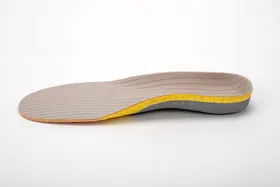Best Materials for Orthotics: How and Why Orthotic Materials Differ
Updated December 19, 2024

With more people looking to avoid medications, orthotics have become essential in treating foot conditions. Medical practitioners prescribe different types of orthotics for many foot, ankle, knee, hip, and lower back problems, as they bring pain relief and promote healing.
As there are so many causes and symptoms of foot conditions, orthotics aren't be made from the same material, as individual needs differ.
These individual-specific needs matter if the orthotics are to be efficient. This need for specificity is one reason over-the-counter orthotics are not the best, except for mild foot conditions.
This article will discuss the different materials used to make orthotics and explain why this difference occurs.
Materials for Different Types of Orthotics
Orthotics are made from a variety of materials. Acrylic, polypropylene, fiberglass, EVA, cork, and foam are some of the most common.
When making orthotics, podiatrists don't use just any material. Several considerations are taken into account before selecting the material.
A few of these considerations are:
- Patient's weight The more a patient weighs, the thicker the material needs to be. The added thickness is necessary to accommodate the weight.
- Shoe style Most podiatrists factor in the preferred shoe style since orthotics have to be used with shoes. The material for a dress shoe is different from that of a work boot. This consideration helps ensure the orthotics fit correctly in the shoe, so they are comfortable and supportive.
- Biomechanical need While some feet need cushioning and added comfort, others need support and motion control. Your individual foot needs will determine the kind of materials used for making your orthotics.
- Type of Orthotics Generally, there are two types of orthotics:
- Functional orthotics
These are molded to the shape of the foot contour, preventing abnormal movement or position of the foot. Because they provide foot control, they are made from hard orthotic materials
like polypropylene (a type of plastic) and carbon graphite. Functional orthotics are useful in treating overpronation, plantar fasciitis, and heel spur syndrome. - Accommodative orthotics These provide protection and relieve pressure by cushioning and padding a painful or injured area. These orthotics tend to be bulkier, but they are made from softer and less rigid materials that can provide the needed cushioning. Such materials include EVAs (Ethylene Vinyl Acetates), neoprene (a type of rubber), and Plastazote (a type of foam). They help treat patients with peripheral neuropathy, Charcot joint disease, pes cavus, clubfoot, or post-polio syndrome.
What Is the Best Material for Your Orthotics?
No single material is the best for every kind of orthotic. Instead, the best material for orthotics depends on their intended use.
For instance, firm, rigid materials like plastic and carbon fiber materials are the best orthotics for flat feet and plantar fasciitis, where rigid orthotics are needed.
In contrast, soft materials like polyethylene and EVA foam are best for flat feet and diabetic or arthritic conditions where soft orthotics are necessary.
Semi-rigid orthotics made from materials like leather, cork, and felt offer both cushioning and rigidity and are used to aid the muscles, tendons, and joints.
» Looking to give your feet a break? Checkout the best insoles for flat feet
How Hard Does Orthotic Material Have to Be?
The hardness of your orthotic material is also directly related to its use. Ultimately, the podiatrist will tell you how hard your orthotic needs to be. They will consider your biomechanical needs, preferences, the type of shoe it will be used in, and the properties of the materials.
Between rigid vs. soft orthotics, rigid orthotics use dense materials. Because of their hardness, you need an extended break-in period during which your feet get used to the orthotics. This is because the stiffer the orthotic is, the longer getting used to the orthotics will take.
It's important to note that stiffer orthotics tend to be thicker and will affect the kind of shoes you can wear. The length and curvature of the orthotic also contribute to the hardness. Ensure you share details about shoes you plan to use your orthotics in when talking to the podiatrist. That way, every necessary detail will be factored into the design during the fabrication.
Lastly, when buying the best insoles, remember that the material will also determine how to clean the orthotics and how long the orthotics will last.
The Bottom Line
Overall, the material for making your orthotics is central to what you can use it for, how you can use it, and the effect you can expect. The best orthotic material is the one that helps you achieve your desired result.








